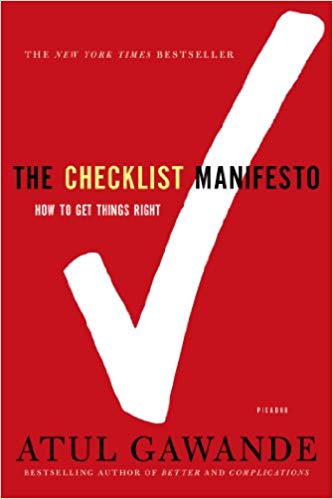

This article is an excerpt from the Shortform summary of "The Checklist Manifesto" by Atul Gawande. Shortform has the world's best summaries of books you should be reading.
Like this article? Sign up for a free trial here .
Today we can do amazing things: we can predict hurricanes and tornadoes, we can build skyscrapers of all shapes, and we can save people from heart attacks and severe injuries that would have been fatal a few decades ago.
Yet highly trained, experienced, and capable people regularly make avoidable mistakes. You may be left wondering, Why do we make mistakes?
We’ll cover Boston surgeon Atul Gawande’s process as he sets out to learn why smart people make avoidable errors and how to prevent them.
Why Do People Make Mistakes?
The result of Gawande’s search is The Checklist Manifesto: How to Get Things Right, in which Gawande proposes a simple solution: a checklist. The book chronicles his exploration of the uses and benefits of checklists in many fields, including aviation, construction, and medicine. While not a how-to manual, his book builds the case for checklists and makes a plea for widespread adoption of checklists as a safety net for human fallibility.
Why do we make mistakes? He argues that we fail to get simple things right because in numerous professions — for instance, medicine, engineering, finance, business, and government — the level and complexity of our collective knowledge has exceeded the capacity of any individual to get everything right.
Most professions, especially medicine, have traditionally responded to failure by requiring more training and experience. Training of medical personnel, police, engineers, and others is more extensive than ever. But while training and experience are important, expertise can’t eliminate human fallibility. What’s needed is a different strategy for preventing failure that takes advantage of knowledge and experience but also compensates for human flaws. The solution is a checklist.
Increasing Complexity
To understand how easy it is to make mistakes, despite our ability as humans to accomplish amazing things, consider how complex medicine has become as it has advanced.
An Israeli study several decades ago showed that the average ICU patient required 178 actions or procedures a day. We have a greater-than-ever chance to save someone who’s seriously ill, but it requires both deciding the right treatment and ensuring that 178 tasks are done correctly each day. There’s as much chance to harm a patient as to help.
Why do we make mistakes? In complex environments, checklists can help to prevent failure by addressing two problems:
- Our memory and attention to detail fail when we’re distracted by more urgent matters.
- People have a tendency to skip steps even when they remember them.
Checklists protect against failures because they remind you of the minimum necessary steps by spelling them out. They allow you to verify each step while also establishing and instilling a performance standard.
Why Do We Make Mistakes? The Aviation Industry Turns to Checklists
In 1935, the Army Air Corps asked airplane manufacturers for a new long-range bomber. Boeing’s Model 299, which exceeded specifications, was favored to win. However, during a flight competition held by the Army in Dayton, Ohio, the Boeing model crashed, killing two crew members.
The plane was much more complicated than previous aircraft — the pilot had many more steps to follow and forgot to release a new locking mechanism on the elevator and rudder controls. To prevent future crashes, Boeing’s test pilots came up with a checklist that fit on an index card, with step-by-step checks for takeoff, landing, and taxiing. Using the checklist, pilots went on to fly the bomber, which became the B-17, 1.8 million miles without incident. Checklists have since become essential in aviation.
World Health Organization Checklist
In 2006, Gawande assisted the World Health Organization (WHO) in solving a problem: Surgery was increasing rapidly worldwide, but surgical patients were getting unsafe care so often that surgery was a public danger. WHO needed a global program that would reduce avoidable harm and deaths from surgery. It’s especially important for doctors to ask themselves, Why do we make mistakes?
Gawande and his team came up with a 19-point checklist. Results of a pilot study at eight hospitals worldwide using the Safe Surgery Checklist exceeded expectations:
- Rates of major complications for surgical patients in all eight hospitals fell by 36 percent. Deaths fell 47 percent.
- Infections fell by almost half.
- The number of patients having to return to the OR because of problems fell by a quarter.
Since the results of the WHO checklist were published, more than a dozen countries pledged to implement checklists. By the end of 2009, about 10 percent of U.S. hospitals and 2,000 worldwide had implemented or pledged to implement the checklist.
Creating a Checklist
So, why do we make mistakes? Our world is complex. We need a simple process to make sure we’re not missing steps. Boeing’s flight deck designer, Daniel Boorman, is an expert on checklists. Before creating a checklist, he recommends two things:
1) Define a clear ‘“pause point” or logical break in the workflow at which the checklist is to be used.
2) Decide whether to create a Do-Confirm list or a Read-Do list.
To use a Do-Confirm checklist, team members perform their jobs from memory. Then they stop and go through the checklist and confirm that everything that was supposed to be done was done. To use a Read-Do checklist, people carry out the tasks as they read them off, like a recipe.
Once you’ve chosen the type of checklist, follow these guidelines:
- Keep the checklist short, typically five to nine items.
- Focus on the “killer” items or steps that are most dangerous to miss.
- Keep the wording simple and exact.
- Use language and terminology familiar to the user.
- Fit the checklist on one page.
- Test your checklist in the real world — have people use it and provide feedback.
Hero With a Checklist
On Jan. 25, 2009, US Airways Flight 1549 left LaGuardia Airport with 155 passengers on board, hit a flock of geese, lost both engines, and crash-landed in the icy Hudson River. Investigators later called it the most successful ditching in aviation history. Pilot Chesley B. “Sully” Sullenberger III was hailed as a hero.
But Sullenberger emphasized repeatedly that it was a team effort. The 155 people on board were saved by something much bigger than individual heroism and skill. It was the crew’s ability to follow vital procedures (checklists) in a crisis, stay calm, communicate, and function as a team. This is the definition of heroism in the modern era.
Checklists don’t replace the need for skill, boldness, and courage — they enhance these qualities by improving focus, making sure you have critical information when you need it, facilitating communication and teamwork, and minimizing human error.
———End of Preview———

Like what you just read? Read the rest of the world's best summary of "The Checklist Manifesto" at Shortform . Learn the book's critical concepts in 20 minutes or less .
Here's what you'll find in our full The Checklist Manifesto summary :
- How checklists save millions of lives in healthcare and flights
- The two types of checklists that matter
- How to create your own revolutionary checklist






